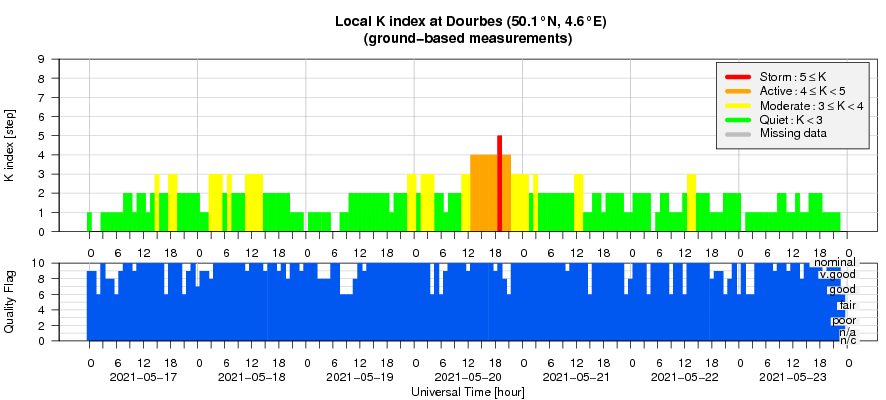- Table of Content
- 1.A festival of ...
- 2.Topical Issue ...
- 3.Review of sola...
- 4.A bunch of Rad...
- 5.PROBA2 Observa...
- 6.The Internatio...
- 7.Noticeable Sol...
- 8.Review of geom...
- 9.Geomagnetic Ob...
- 10.The SIDC Space...
- 11.Review of iono...
- 12.STCE in action...
2. Topical Issue on "Ionospheric scintillations" for JSWSC
3. Review of solar activity
4. A bunch of Radio events
5. PROBA2 Observations (17 May 2021 - 23 May 2021)
6. The International Sunspot Number by Silso
7. Noticeable Solar Events (17 May 2021 - 23 May 2021)
8. Review of geomagnetic activity
9. Geomagnetic Observations at Dourbes (17 May 2021 - 23 May 2021)
10. The SIDC Space Weather Briefing
11. Review of ionospheric activity (17 May 2021 - 23 May 2021)
12. STCE in action: upcoming events
A festival of M-class flares
NOAA 2824 rotated over the northeast solar limb as a single, mature sunspot on 17 May. Starting on 21 May, flux of a magnetic polarity opposite to that of the main sunspot started to emerge to the southeast and to the west of this spot. This can be seen in the SDO/HMI (https://sdo.gsfc.nasa.gov/data/aiahmi/ ) imagery underneath, with on the left white light imagery and on the right the magnetogram of the active region, the red and blue colors representing respectively positive (field lines energing from the Sun) and negative (field lines returning to the Sun) magnetic fields. As the flux emerged, small satellite spots could be seen forming around the main mature spot. The overall outlook is similar to e.g. the active regions NOAA 2158 (see the STCE Newsitem https://www.stce.be/news/268/welcome.html ) and NOAA 9236 (https://www.stce.be/news/244/welcome.html ). However, those regions were much larger than NOAA 2824 and were able to sustain the magnetically unstable region, hence they were able to produce much stronger flares all the way up into the X-class range.
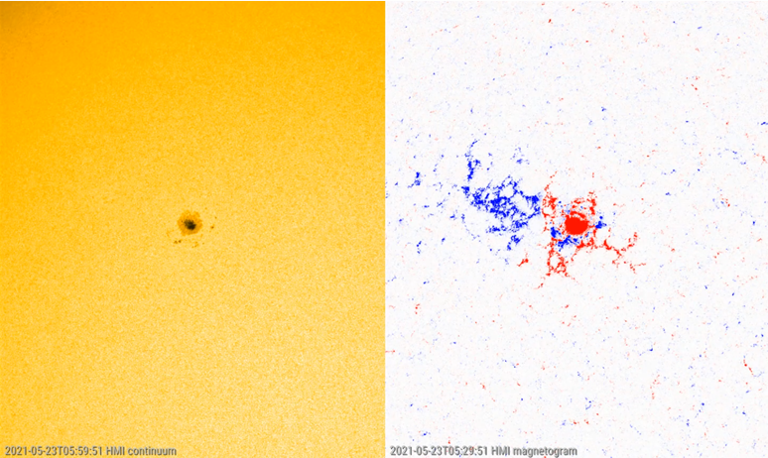
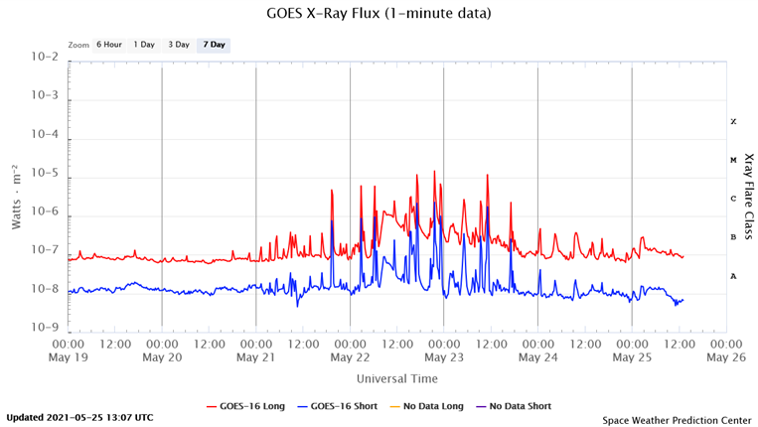
For NOAA 2824, the emergence of the areas of mixed magnetic polarity gradually drove the flaring frequency and intensity upwards, with 14 C- and 3 M-class flares in just 48 hours, a frequency not seen since the last active episode in September 2017. The evolution can be seen in the GOES X-ray flux plot above. The 3 M-class flares were all of the M1 level, with the first one originating from the area to the southeast ("lower left") of the main sunspot, and the two other M-class flares coming from the active area to the west ("right") of this sunspot. This can be seen in the online animation (https://www.stce.be/news/531/welcome.html ), which shows the flaring in this active region from 21 May (06UT) till 24 May (06UT) thru the SDO/AIA 131 filter. The still underneath captures the 2nd M1 flare near its peak x-ray intensity. The 3rd M-class flare happened during the noon hours of 23 May, and an associated group of Type III radio bursts (see the SWx classification page at https://www.stce.be/educational/classification#radio and the Humain SC25 page at http://sidc.be/humain/hsrs_events_cycle_25.php) was nicely captured by the Humain solar radio observatory (http://www.sidc.be/humain/flux_realtime.php ). After this last M-class event, the areas of magnetic mixing gradually dissipated and so the flaring activity dwindled down accordingly.
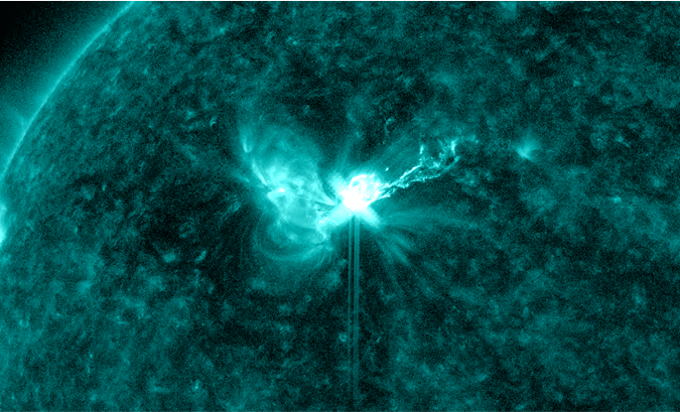
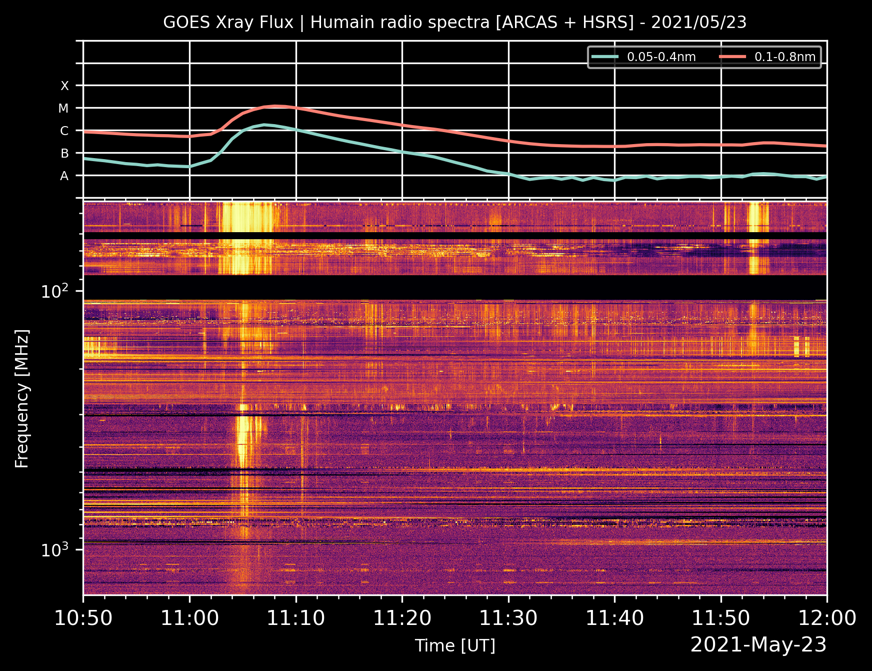
Topical Issue on "Ionospheric scintillations" for JSWSC
The Journal of Space Weather and Space Climate (JSWSC - https://www.swsc-journal.org/ ) has opened a new Topical Issue "Towards better understanding of the ionospheric plasma irregularities and scintillations" (https://www.swsc-journal.org/topical-issues-open-for-submission ) to appear in 2021/2022.
This Topical Issue arises from the virtual European Geophysical Union General Assembly (vEGU21) held in April 2021, primarily from the Session ST3.3 entitled "Towards better understanding of the ionospheric plasma irregularities and scintillations" (https://meetingorganizer.copernicus.org/EGU21/session/40166 ). However, it is not reserved to papers presented during this session and is open for all submissions within the scope.
Plasma density irregularities can occur at all latitudes in the Earth's ionosphere. However, the onset and evolution of these irregularities as well as their influence on the radio wave signals continue to be unsolved scientific questions. The various proposed generation mechanisms, including instability growth rates and seeding processes, are strongly coupled to the neutral atmosphere and magnetospheric dynamics, making the forecasting of ionospheric irregularities much more challenging. Recent observations from ground- and space-based measurements, as well as new innovative data analysis and modeling techniques, e.g., data assimilation and machine learning, have the potential to advance our understanding of the ionospheric irregularities. Studies that focus on the observation, modeling and prediction of ionospheric plasma irregularities of different scales are welcome to be submitted to this topical issue in Journal of Space Weather and Space Climate (JSWSC). The mitigation of negative effects and recent developments to forecast scintillation effects on Global Navigation Satellite or other communication systems are also of high interest.
Manuscripts must be submitted via the JSWSC online submission tool. Guidelines for submission of papers are found on the JSWSC web site under the tab "Instruction for Authors" (https://www.swsc-journal.org/author-information/instructions-for-authors ).
Deadline: 30 November 2021
All manuscripts will be peer reviewed according to the quality standards of international scientific journals. The type of contributions must fit the style of JSWSC. All manuscripts should contain enough new insight, present the results against a properly referenced background of existing work, and present adequate evidence that supports the conclusions. Accepted papers are published in electronic format only, and are freely available to everyone via the JSWSC website. JSWSC offers the possibility to include electronic material, such as animations, movies, codes and data.
The Topical Editor-in-Chief (T-EiC) for this TI is Chao Xiong (xiongchao@whu.edu.cn) from the Wuhan University, Wuhan, China. He will be joined by 4 Topical Editors (TE):
- Lucilla Alfonsi, Istituto Nazionale di Geofisica e Vulcanologia (INGV), Roma, Italy
- Jens Berdermann, German Aerospace Center (DLR), Neustrelitz, Germany
- Yaqi Jin, University of Oslo, Oslo, Norway
- Jeffrey Klenzing, NASA Goddard Space Flight Center, Greenbelt, MD, USA
For questions regarding this Topical Issue, please, contact the T-EiC (xiongchao@whu.edu.cn). For questions concerning the submission process the Editorial Office (jswsc@edpsciences.org) should be contacted.
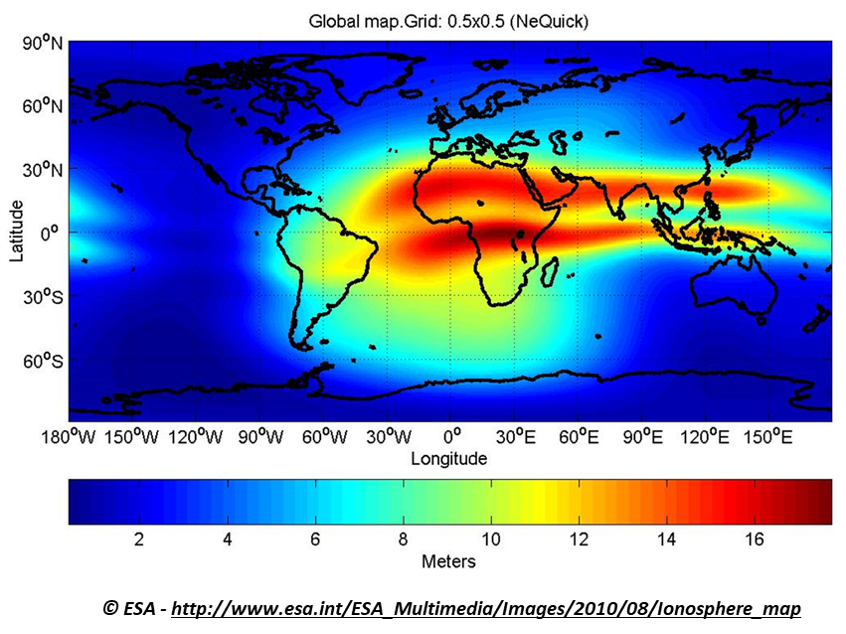
Review of solar activity
At the beginning of the week, one active region was visible: NOAA AR 2822 (Catania 93, alpha magnetic field configuration). It did not produce any significant flares. On May 17 NOAA AR 2824 rotated over the west limb (Catania 96, beta magnetic field configuration), already producing C-class flares. After one day it decayed to an alpha magnetic field configuration and produced only B-class flares. This region then increased in complexity, its photospheric magnetic field was classified as beta gamma by May 22. It produced then three M-class flares: M1.1 peaking at 17:11 UT on May 22, M1.4 flare peaking at 21:36 UT on 22 May, M1.1 peaking at 11:08 UT on May 23.
Three (partially) Earth directed CMEs erupted on 22 May. Two of them are associated with M-class flares. The first one became visible at 09:12 UT (LASCO C2), had a speed of 300 km/s and was about 90 degrees angular wide. The second one became visible at 16:23 UT (COR2A) and had a speed of 460 km/s. The third CME was visible from 22:00 UT (COR2A) and had a speed of 629 km/s. The last two were faint in LASCO and better visible in COR2. The speed of the CMEs increased from the first to the third, so they will encounter and interact on their way to the Earth.
On 23 May one more (partially) Earth directed CME was observed, at 11:00 UT on COR2A with a speed of 680 km/s.
The greater than 10 MeV proton flux was below the threshold the full week. The greater than 2 MeV electron flux remained below the 1000 pfu during the week. The 24-hour electron fluence was at normal levels during the whole week.
A bunch of Radio events
The HSRS and ARCAS spectrometers operated from the Human Radioastronomy Station observed following radio events:
22 May 2021, 11:12 - 11:27, group of type III burst, associated with a C2.5 flare in NOAA AR 2824
22 May 2021, 13:10 - 13:27, groups of type III bursts
22 May 2021, 14:06 - 14:14, group of type III bursts - local thunderstorm (14:15-14:19), associated with C1.1 flare in NOAA AR 2824
22 May 2021, 15:00 - 15:30, groups of type III bursts, associated with a C3.2 flare in NOAA AR 2824
23 May 2021, 09:16 - 09:28, group of type III bursts, associated with a C2.4 flare in NOAA AR 2824
23 May 2021, 10:50 - 12:00, groups of type III bursts, associated with a M1.1 flare in NOAA AR 2824
23 May 2021, 14:14 - 14:25, groups of type III bursts
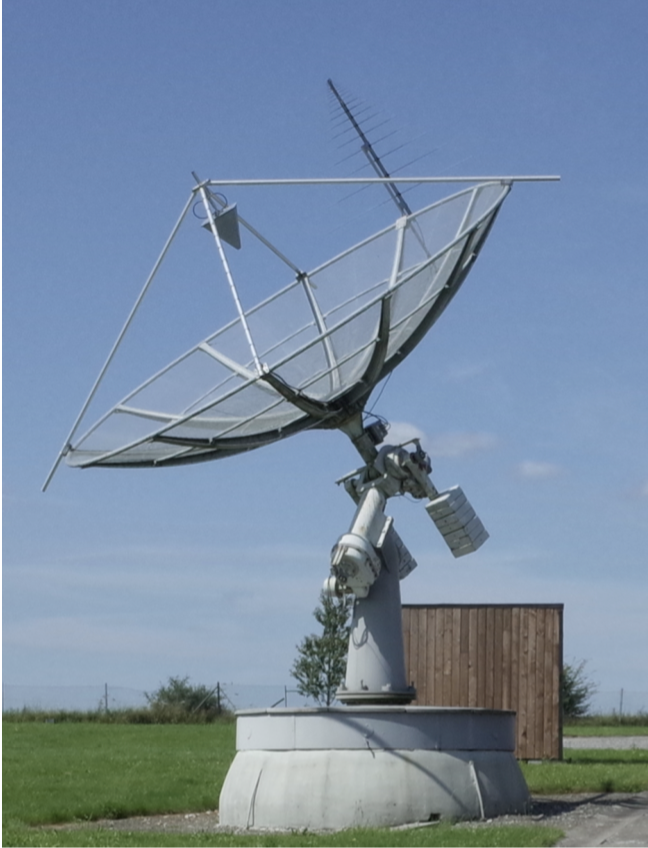
Check the quicklook and the complete list of radio events of solar cycle 25: http://sidc.be/humain/hsrs_events_cycle_25.php
PROBA2 Observations (17 May 2021 - 23 May 2021)
Solar Activity
Solar flare activity fluctuated between very low and moderate during the week.
In order to view the activity of this week in more detail, we suggest to go to the following website from which all the daily (normal and difference) movies can be accessed: https://proba2.oma.be/ssa
This page also lists the recorded flaring events.
A weekly overview movie can be found here (SWAP week 582): https://proba2.sidc.be/swap/data/mpg/movies/weekly_movies/weekly_movie_2021_05_17.mp4
Details about some of this week's events can be found further below.
If any of the linked movies are unavailable they can be found in the P2SC movie repository here: https://proba2.oma.be/swap/data/mpg/movies/.
Saturday May 22
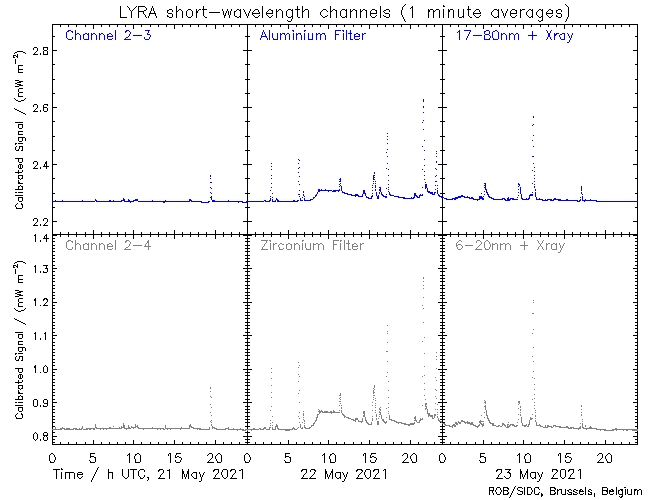
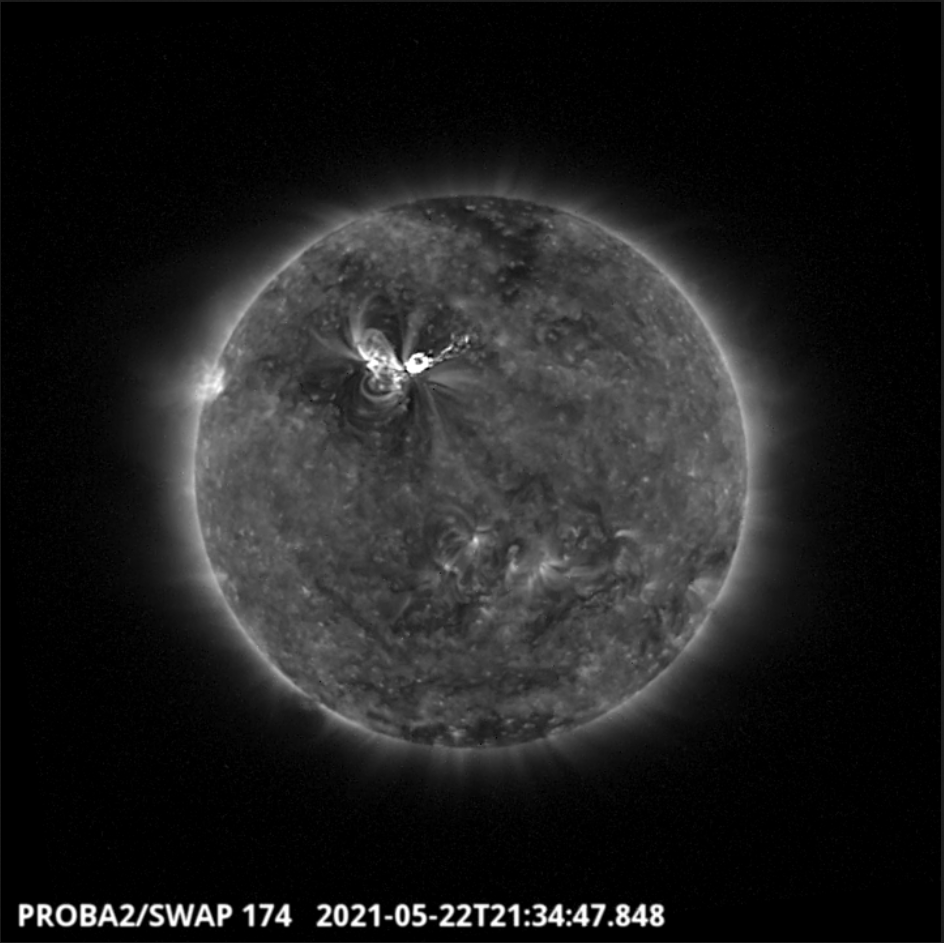
The largest flare of the week, an M1.4 flare, was observed by SWAP and LYRA. The flare and associated eruption is visible in the northern hemisphere of the solar disk on 2021-May-22, as shown in the SWAP image above taken at 21:34 UT.
Find a movie of the entire day here: https://proba2.sidc.be/swap/movies/20210522_swap_movie.mp4 (SWAP movie) and here: https://proba2.sidc.be/swap/movies/20210522_swap_diff.mp4 (SWAP difference movie).
The International Sunspot Number by Silso
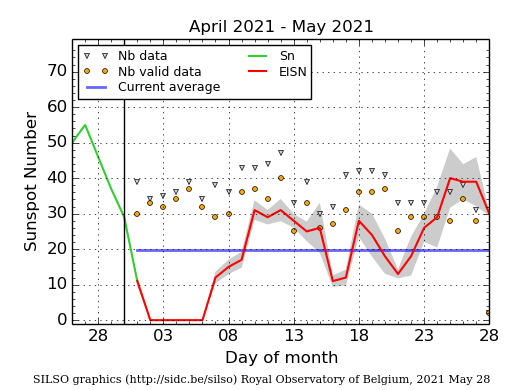
The daily Estimated International Sunspot Number (EISN, red curve with shaded error) derived by a simplified method from real-time data from the worldwide SILSO network. It extends the official Sunspot Number from the full processing of the preceding month (green line), a few days more than one solar rotation. The horizontal blue line shows the current monthly average. The yellow dots gives the number of stations that provided valid data. Valid data are used to calculate the EISN. The triangle gives the number of stations providing data. When a triangle and a yellow dot coincide, it means that all the data is used to calculate the EISN of that day.
Noticeable Solar Events (17 May 2021 - 23 May 2021)
| DAY | BEGIN | MAX | END | LOC | XRAY | OP | 10CM | TYPE | Cat | NOAA |
| 22 | 1703 | 1711 | 1716 | N17E20 | M1.1 | 1N | 17 | III/2 | 96 | 2824 |
| 22 | 2130 | 2136 | 2143 | N19E15 | M1.4 | 1N | 40 | 96 | 2824 | |
| 23 | 1100 | 1108 | 1114 | N19E10 | M1.1 | 2N | 85 | III/2 | 96 | 2824 |
| LOC: approximate heliographic location | TYPE: radio burst type |
| XRAY: X-ray flare class | Cat: Catania sunspot group number |
| OP: optical flare class | NOAA: NOAA active region number |
| 10CM: peak 10 cm radio flux |
Review of geomagnetic activity
Earth was immersed in slow solar wind until 20 May when the fast solar wind from a negative polarity coronal hole arrived at Earth. The solar wind speed then increased to 600 km/s, with interplanetary magnetic field magnitudes up to 19 nT, with Bz reaching - 13 nT.
As a consequence, geomagnetic conditions reached minor storm levels, both locally and at planetary levels (KDourbes 2-5, Kp 2-5).
On 17 May at 15:45 UT, a weak shock arrived at Earth, corresponding to the CME seen on 13 May. After the shock, the interplanetary magnetic field reached 10 nT (with Bz up to -9 nT), Kp reached 4, KDourbes 3.
The SIDC Space Weather Briefing
The Space Weather Briefing presented by the forecaster on duty from May 16 to 23. It reflects in images and graphs what is written in the Solar and Geomagnetic Activity report.

A pdf-version: https://www.stce.be/briefings/20210524_SWbriefing.pdf
The movie: https://www.stce.be/briefings/20210524_SWbriefing.m4v
Review of ionospheric activity (17 May 2021 - 23 May 2021)
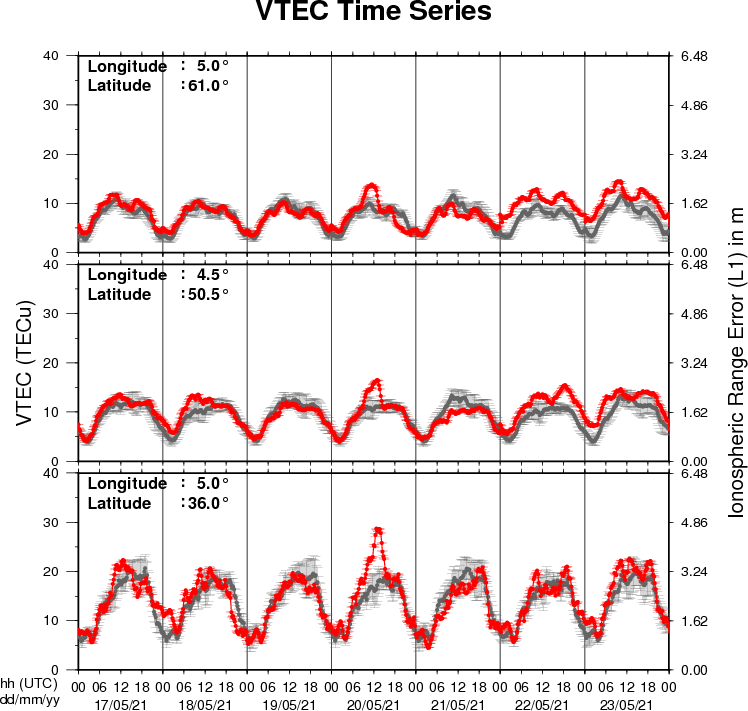
The figure shows the time evolution of the Vertical Total Electron Content (VTEC) (in red) during the last week at three locations:
a) in the northern part of Europe(N61°, 5°E)
b) above Brussels(N50.5°, 4.5°E)
c) in the southern part of Europe(N36°, 5°E)
This figure also shows (in grey) the normal ionospheric behaviour expected based on the median VTEC from the 15 previous days.
The VTEC is expressed in TECu (with TECu=10^16 electrons per square meter) and is directly related to the signal propagation delay due to the ionosphere (in figure: delay on GPS L1 frequency).
The Sun's radiation ionizes the Earth's upper atmosphere, the ionosphere, located from about 60km to 1000km above the Earth's surface.The ionization process in the ionosphere produces ions and free electrons. These electrons perturb the propagation of the GNSS (Global Navigation Satellite System) signals by inducing a so-called ionospheric delay.
See http://stce.be/newsletter/GNSS_final.pdf for some more explanations ; for detailed information, see http://gnss.be/ionosphere_tutorial.php
STCE in action: upcoming events
Check out our activity calendar: activities and encounters with space weather as main theme. We provide occasions to get submerged in the world of space weather through educational, informative and instructive activities.
Due to COVID, these activities and events are organised online.
June 2, 14:30 - seminar: Predicting geo-effectiveness of CMEs with EUHFORIA by Anwesha Maharana - organised by the ROB solar physics department
June 3, 14:00 - seminar: A new marker of solar eruptivity by Luis Linan - organised by CmPA (KULeuven)

Details on: https://www.stce.be/calendar
